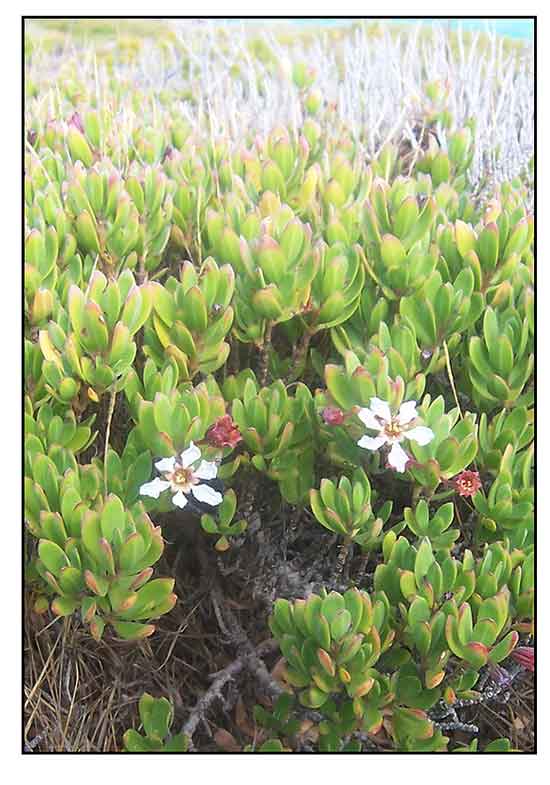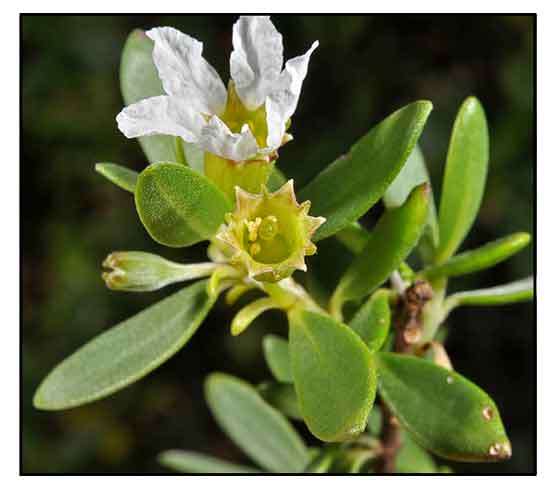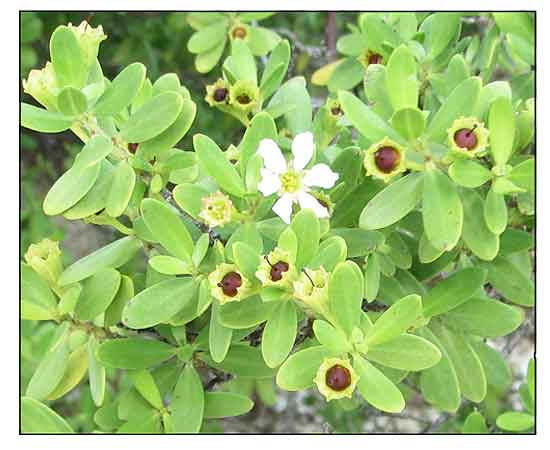 Gen info Gen info
- Pemphis acidula is a species of flowering plant in the family Lythraceae; a mangrove found throughout most of the tropical Indo-Pacific, growing on rocky shores. (2)
- The genus Pemphis was first described in 1775, and was long considered be a monotypic (single) species. (2) The Plant List lists Pemphis madagascariensis (Baker) Koehne as a second species.
- The genus name Pemphis derives from Greek, meaning "swelling", referring to the swollen mature fruits. The species epithet acidula is Latin, meaning "sour", referring to the taste of the leaves. (3)
- Due to its typhoon resistance, it is a common species used in bonsai. Due to its high value among bonsai enthusiasts, popular for its rugged, gnarled and twisted trunk, and destruction of its natural habitat, it is classified a "threatened" species by the Department of Environment and Natural Resources in the Philippines, and collection, selling, and transport is illegal and punishable by finds and/or imprisonment. (2)
Botany
Pemphis acidula is a shrub to densely branched, spreading tree, maritime, small, to 11 m tall, but often ca. 1 m. Stems and branchlets ascending; branchlets, young leaves, and inflorescences densely silky grayish white strigose. Leaves opposite, sessile or subsessile; petiole to 2 mm; leaf blade narrowly elliptic to lanceolate, 1-3 cm × 5-15 mm, thick, succulent, base attenuate, apex often terminating in a minute circular hydathode. Flowers solitary or paired, axillary, 6-merous, actinomorphic, heteromorphic, distylous; pedicel 5-13 m. Floral tube 4-5 mm, turbinate, 12-ribbed, thick walled, densely grayish white strigose; sepals short, ca. 1/4 as long as floral tube; epicalyx segments equaling sepals or ca. 1/2 as long. Petals 6, white or pale pink, obovate to suborbicular, 3-5 mm. Stamens 12, scarcely biseriate, 6 exserted in short-styled thrum flowers, all included in long-styled pin flowers. Ovary vestigially 3- or 4-loculed, appearing 1-loculed with free central placentation at maturity; ovules ascending on short placenta; style long-exserted in pin flowers, included in thrum flowers; stigma capitate. Capsules dry, circumscissile, obovoid, ca. 6 mm, slightly exserted at maturity. Seeds ca. 20, irregularly obpyramidal, not winged, 2-3 mm. 2n = 32. (Flora of China)
An evergreen shrub or small tree up to 10 m tall; bole often short and crooked, up to 20(-40) cm in diameter; bark surface becoming deeply fissured with age and flaking into long strips, light grey to dark grey-brown, inner bark laminated, light reddish. Twigs angular, densely hairy. Leaves decussate, simple, entire, fleshy, subsessile, silky-haired; stipules absent. Flowers axillary, solitary or in pairs, 6-merous, heterostylous; calyx bell-shaped or tubular; petals inserted near the mouth of the calyx tube, white, clawed; stamens 12 or rarely 18, in 2 dimorphic series; ovary superior, 1-locular with many ovules, style 1. Fruit a capsule, enclosed in the calyx tube, the upper half falling as a lid. Seed with thick marginal wings. (4)
 Distribution Distribution
- Native to the Philippines.
- Native range is Somalia to Mazambique and Pacific, Australia.
- Grows primarily in the wet tropical biome. (1)
- Also native to Aldabra, Andaman Is., Australia, Bismarck Archipelago, Borneo, Cambodia, Caroline Is., Chagos Archipelago, Christmas I., Cocos Is., Comoros, Cook Is., Fiji, Gilbert Is., India, Jawa, Kenya, Laccadive Is., Lesser Sunda Is., Line Is., Malaya, Maldives, Maluku, Marianas, Marshall Is., Mauritius, Mozambique, Mozambique Channel I, Myanmar, Nansei-shoto, New Caledonia, New Guinea, Niue, Northern Territory, Philippines, Phoenix Is., Pitcairn Is., Queensland, Réunion, Samoa, Society Is., Solomon Is., Somalia, South China Sea, Sri Lanka, Sulawesi, Sumatera, Taiwan, Tanzania, Thailand, Tokelau-Manihiki, Tonga, Tuamotu, Tuvalu, Vanuatu, Vietnam, Wake I., Wallis-Futuna Is. (1)
- Grows on rocky or sandy coasts and fringes of mangroves, often submerged during high tide. (3)
 Constituents Constituents
- Phytochemical screening of aqueous extract of whole plant yielded the presence of flavonoids, phenols, terpenoids, saponins, tannins, glycosides, and xanthoproteins. (see study below) (7)
Properties
- Considered abortifacient. (Bark yields 19-43% tannin. Invitro tests of bark showed increased activity, amplitude, and frequency of uterine contractions, which confirms traditional Vanuatu use as abortifacient. (16)
-
Studies have suggested antibacterial, mosquito larvicidal, repellent, antioxidant, anti-inflammatory, anticancer, melanogenesis inhibitory, topoisomerase inhibitory properties.
Parts used
Bark, leaves, stems.
Uses
Edibility
-
Fruits and acidic leaves are edible.
- Fleshy leaves used as pot herb.
- Bark and wood mixed with toddy palm used as baby food inn some Pacific Islands. (3)
Folkloric
- No reported folkloric medicinal use in the Philippines.
-
In Indonesia, stem bark traditionally used to treat recurrent aphthous stomatitis. (9)
- In Australia bush medicine, tip of burnt twig applied to site of toothache.
- In Vanuatu, traditionally used as abortifacient. (16)
Others
- Wood: Valued for its hard and heavy wood with a naturally fine finish, resistant to rot and warping. Hardwood has a density of 1100-1210 kg/m3 at 15% moisture. Heartwood is reddish brown to dark reddish-brown, turning dark brown with age; with a very fine texture and lustrous wood. (4)
- Craft and construction: Used for making walking canes, fence posts, tool handles, pestles, weapons, combs, and even anchors. In the Maldives, the wood is used in traditional shipbuilding to hold planks of the hull together. Also, to fashion "nails" in local sorcery. (2)
- Ornamental: A popular plant among bonsai enthusiasts.
- Tannin: Bark contains 19-43% tannin.
- Dye: Scrapped bark yields a red dye. (3)
- Fodder: Fruits eaten or used as animal feed. (3)
- Fuel: Wood used as fuel; makes a good charcoal.
Studies
• Antibacterial: Study evaluated the antibacterial activity of various extracts of Pemphis acidula viz., methanol, benzene, and acetone by disc diffusion method against pathogenic bacteria viz., S. aureus, E. coli, P. aeruginosa, M. luteus, and R. rhodochrous. Methanol extract showed maximum zone of inhibition of 17.0 mm against M. luteus at concentration of 10%. The benzene and acetone extracts showed same range of inhibition against all bacterial tested. Increase in extract concentration was associated with increased zone of inhibition. (5)
• Larvicidal / Ovicidal / Repellent against Dengue Vector Mosquitoes / Leaves: Study evaluated crude leaf extracts of P. acidula for larvicidal, ovicidal and repellent activities against Culex quinquefasciatus and Aedes aegypti. LC50 for methanol, benzene, and acetone were 10.81, 41.07, 52.22 and 22.10, 43.99, 57.66, respectively. A 100% ovicidal activity was observed at 350 and 450 ppm. Skin repellent test at 1,0, 2.5, and 5.0 mg/cm2 gave 100% protection up to 2.30, 4,00 and 6.45 hrs and 2.45, 4.30, and 7.0 hrs, respectively. Results suggest potential for effective control of Ae. aegypti and Cx. quinquefasciatus. (6) Study evaluated the larvicidal and ovicidal potential of crude methanol, benzene, and acetone solvent extracts against medically important mosquito vectors viz., Culex tritaeniorhynchus and Anopheles subpictus. The LC50 and LC90 of 10.81 and 20.64 and 22.10 and 43.71 ppm and hundred percent egg mortality at 350 and 400 ppm methanol extract of P. acidula against Ct and As, respectively. Results suggest potential ecofriendly use for control of mosquitoes. (12)
• Silver Nanoparticles / Antioxidant / Anti-Inflammatory : Study evaluated the easy and eco-friendly synthesis of silver nanoparticles using aqueous whole plant extract of P. acidula as reducing, stabilizing, and capping agents. The AgNPs showed strong antioxidant activity by DPPH and H2O2 scavenging assays and displayed strong anti-inflammatory activity by albumin denaturation and proteinase inhibitory activity. (see constituents above) (7)
• Galloyl Flavonol Glycosides / Antioxidant / Leaves: Study of leaf extract isolated four kinds of galloyl flavonol glycosides, which were elucidated to be quercetin or kaempferol 6"-O-galloyl-ß-D-glycosides. The galloyl flavonoids showed more efficient antioxidant activity than corresponding flavonol glycosides using DPPH antiradical activity, inhibition of methyl linoleate oxidation, and inhibition of oxidative cell death. (8)
• Topoisomerase-I Inhibitor / Antioxidant / Antibacterial / Stem Bark: Study of evaluated the stem bark of P. acidula for antibacterial, antioxidant, and topoisomerase-I inhibitory activity. Topoisomerase-I is one of the target molecules for anticancer drugs. The ethyl acetate and methanol extracts inhibited the growth of target bacteria viz., S. aureus, P. aeruginosa, E. coli. and S. mutans and showed high antioxidant activity. The methanol extract inhibited topoisomerase-I activity at concentration of 7.5 µg/mL. Results suggest a correlation between antibacterial, antioxidant, and topoisomerase inhibitory activity. (9)
• Melanogenesis Inhibition in Mouse B16 Melanoma Cells / Potential Skin Whitening: Study evaluated the inhibitory effect of P. acidula water extract (PAE) on melanogenesis in mouse B16 melanoma cells. The PAE inhibited melanogenesis in 3-isobutyl-1-methylxanthin IIBMX)-stimulated B16 cells in a dose-dependent manner with IC50 of 33.5 µg/ml, along with inhibition of cellular tyrosinase activity. Results suggest the PAE inhibited melanogenesis of B16 by reducing tyrosinase gene expression. Study suggests potential as a skin-whitening agent for the treatment of skin pigmentation. (10)
• Antibacterial / Leaves and Bark: Study evaluated the antibacterial activity of various extracts of leaves and bark extracts of Pemphis acidula and Ceriops tagal against human pathogens viz., P. aeruginosa, K. pneumonia, V. parahemolyticus, S. aureus, and V. cholera. P. acidula showed higher antibacterial potency than Ceriops tagal, with the bark methanol extract showing highest activity against S. aureus (17.2 mm). (11)
• Cytotoxicity against MCF-7 Cells / Leaves: Study evaluated the cytotoxic potential of leaves and stem bark extracts of 15 mangrove plants grown in Sri Lanka on breast cancer (MCF-7) and hepatocellular carcinoma (HepG2) cells. The chloroform extract of leaves of P. acidula showed selective cytotoxic effects against MCF-7 cells. (13)
• Effect of Storage on Seed Viability: Study evaluated the effects pf dessication or seed moisture content and potential of long-term storage of seeds as a form of ex-situ conservation. It reassessed the potential of long-term storage under different relative humidity conditions. Results showed the length of storage can affect seeds viability under certain conditions. Short-term storage seeds may have greater germination performance every with high moisture content. Conversely, for long-term storage drier seeds can perform better. (15)
Availability
Wild-crafted.
Ornamental cultivation.
|

![]()






